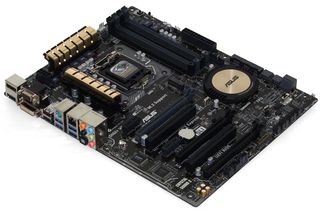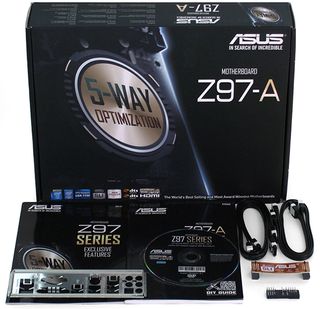Intel Z97 Express: Five Enthusiast Motherboards, $120 To $160
Tom’s Hardware readers set a higher bar for enthusiast-class motherboards, demanding overclocking capabilities and more robust feature sets. Priced from $120 to $160, we welcome the first five Z97 motherboards to our enhanced definition of mainstream!
Asus Z97-A
Asus is so excited about SATA-Express (and its potential for differentiation) that the firm developed its own “Hyper Express” drive enclosure to leverage two mSATA SSDs against the new interface. We could have simply configured a couple of our own 2.5” SSDs in RAID using the chipset’s native interface, but that would have required two 2.5” drive bays.

Lacking added-in SATA or USB controllers, the Z97-A places four of the Z97’s six USB 3.0 ports on the I/O panel along with two of the chipset’s USB 2.0 ports. Higher up that panel are DisplayPort, HDMI, VGA, and DVI-D outputs that interface with the processor's GPU, which can drive three independent monitors.

The two PCIe 2.0 lanes saved by not adding a bunch of extra controllers are instead sent to the bottom PCIe x16 slot. I wouldn’t recommend using that slot for any sort of multi-GPU array, though it's still suitable for lower-bandwidth applications like building a display wall or even dedicating an older board to PhysX acceleration.
In spite of its relative simplicity, the Z97-A does eventually run out of PCIe lanes as it's filled with devices. The M.2 slot, for example, uses the same lanes as the two PCIe x1 slots, and that’s probably why Asus disables M.2 by default. Focus instead shifts towards keeping the two PCIe lanes of SATA Express open, since the company wants to be on the leading edge of SATA-E's development.
Asus-exclusive features like TPU (automatic overclocking), EPU (energy-saving underclocking), and MemOK (stability-enhanced memory setting) are still addressed by on-board buttons and switches. But Asus adds one more firmware-modifying piece of hardware in its EZ-XMP switch. New builders who might be afraid of UEFI menus can now enable this overclocking technology without losing their nerve, and commercial builders can enable full memory performance without concern that their customers might reset it.

The Z97-A includes four SATA cables, an SLI bridge, and some front-panel connector extenders that ease the bundling of loose cable ends (such as Power, Reset, and LED).
Stay on the Cutting Edge
Join the experts who read Tom's Hardware for the inside track on enthusiast PC tech news — and have for over 25 years. We'll send breaking news and in-depth reviews of CPUs, GPUs, AI, maker hardware and more straight to your inbox.
-
onover The table detailing the motherboard features on page 1 ... Is it just me, or is the text a bit small?Reply -
makishima ReplyThe table detailing the motherboard features on page 1 ... Is it just me, or is the text a bit small?
I find it small -
Someone Somewhere I'd like to see a review on the significance of the 'killer' NICs... I highly doubt they have any difference besides branding.Reply -
SteelCity1981 so intel it seems doesn't have much faith in their own thunderbolt considering there is no thunderbolt ports on this new chipset!Reply -
H4X3R The Asrock one is better. Not everyone will be using XSplit, and as tradesman1 (a moderator on this site) said "I myself won't touch MSI mobos due to the poor QC".Reply -
Crashman Reply
READ PAGE ONE to find out why this chipset has the same features as the previous chipset.13285086 said:so intel it seems doesn't have much faith in their own thunderbolt considering there is no thunderbolt ports on this new chipset!
-
H4X3R Good review :) I am looking forward to the best price:features motherboard review though (extreme6). I have a quick question crashman: Do asrock still use Capxxon caps (or just crappy caps in general). I would like to know the company of the caps if possible, once again, thank you :)Reply -
Crashman Reply
I wish I knew. It appears that they get their caps custom-wrapped to get the gold color, and that the custom wrapping only has specifications (no branding).13285142 said:Good review :) I am looking forward to the best price:features motherboard review though (extreme6). I have a quick question crashman: Do asrock still use Capxxon caps (or just crappy caps in general). I would like to know the company of the caps if possible, once again, thank you :)
-
tarkhein ReplyI'd like to see a review on the significance of the 'killer' NICs... I highly doubt they have any difference besides branding.
Not exactly the most comprehensive review, but here is Asus' take on NICs: http://rog.asus.com/312772014/labels/guides/tried-and-tested-why-intel-ethernet-is-still-better-for-gaming/ -
Someone Somewhere Of course, they're testing throughput, and latency is what is generally considered to matter.Reply
Most Popular


